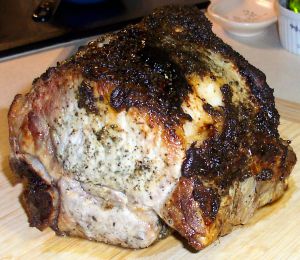Guide for Roasting Pork
http://teriskitchen.com/pork-recipes/guide-for-roasting-pork.htmlI do not make a large pork roast very often, but I usually go all out on New Year's Day. That was the thought behind this roasting guide. There are several cuts of pork that can be used, so I have listed the roasting times and temperatures rather than limit it to one particular size and type of meat.
A boneless loin is great for a small gathering. For a large group of people, I use a whole fresh ham, picnic, shoulder, bone-in loin (see image) or blade roast. If you want to be extra festive, try a crown roast, which is made from two center-rib roasts, and put your favorite stuffing in the center. Weigh the roast with the stuffing when calculating roasting time. For individual recipes using specific cuts of pork, see the similar and related recipes, as well as the Pork Recipes page.
Preparation
Let the roast set at room temperature for about one hour, depending on size. Place in large, shallow roasting pan. For this presentation, no matter what type of a roast I am using or what other seasonings I will add, I always rub the meat with either yellow or Dijon mustard prior to roasting. Garlic, rosemary, thyme and/or sage can also be added. Salt and pepper to taste. Preheat oven to the desired temperature as listed below.
Roasting Temperatures and Times
Since pork has become so lean, it requires some special treatment to ensure that it does not dry out. This could be done by roasting at a constant temperature of 325° F. For larger roasts, I prefer to start at a higher temperature of 400° F for the first 10 minutes, then reduce to 325°. This allows for a crisping of the outside of the meat. Large cuts with bones require about 20 minutes per pound. Smaller cuts and boneless roasts require 25 minutes per pound. However, do not trust the 'minutes per pound' method exclusively. Always start checking the internal temperature of any roast with an instant-read thermometer before it is supposed to be done. Cuts of meat and ovens can make a major difference. The internal temperature of lean pork should be about 145°, no more than 150° as the temperature will continue to rise as it rests. However, fattier and tougher cuts will benefit if roasted to a higher temperature or until fork tender. Insert the thermometer in the thickest part of the roast to check for doneness. Baste several times with pan juices while roasting to help retain moistness.
When the roast is done, remove it from oven and place on a board or platter. Tent with foil and allow to rest before serving for 10 to 20 minutes, depending on size. If desired, make your favorite gravy or sauce using the pan juices while the meat is resting.
 http://teriskitchen.com
http://teriskitchen.com